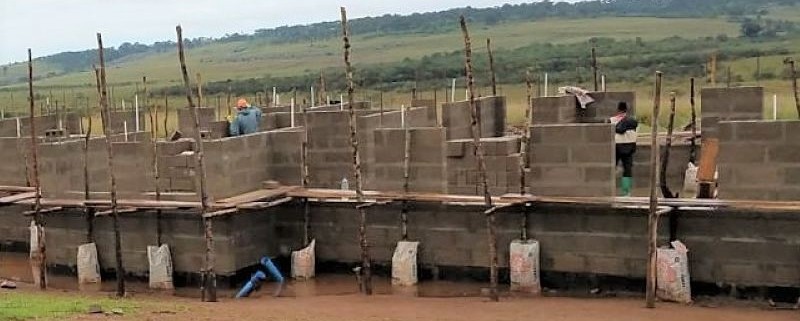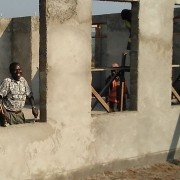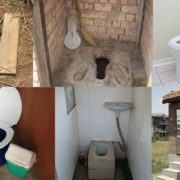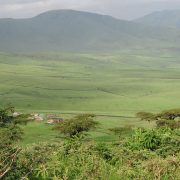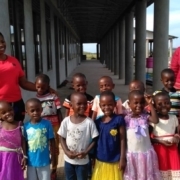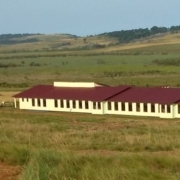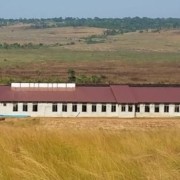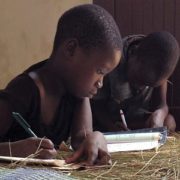Going Up!
Twegashe School is on the way up! Here is a rundown of what’s been happening on construction in the past few months.
The crew
Because there are no skilled construction workers in Bushasha, we’ve hired a builder from town who brings his own crew to the site. These workers stay on site during the week to avoid the long daily commute. Several members of our original village crew who showed the most aptitude for construction tasks are working alongside these trained builders, and learning valuable construction skills at the same time.
It’s not only the village workers who are learning. The reinforced masonry technique we are using is not common here, even in towns and cities. So the builder and crew from town are also learning new skills from our volunteer construction supervisor, Bill Suhr. Even the government building inspectors from town are eager to learn new details about this method when they come to inspect.
Foundations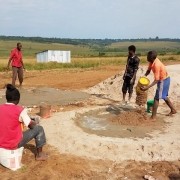
In August the crew began pouring foundations. Without a cement truck or even a hand mixer, they mixed the concrete in rustic “concrete mixing bowls”. These bowls are prepared by digging a large depression and lining it with cement. After mixing the concrete by hand in a one of these mixing bowls, workers carried it, one bucket at a time, to pour the entire school building foundation—by all accounts a very difficult and tiring task!
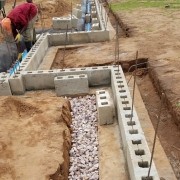 Stem wall
Stem wall
The next step was construction of the stem wall, a single row of blocks on top of the foundation that helps tie the walls to the foundation (see photo). The gravel-lined trench next to the foundation on the outer side is a French drain to carry water away from the building. To install the drain they needed perforated PVC pipe, but there is no such product available in the Bukoba area. Instead, they purchased regular PVC pipe and drilled their own holes!
 Slab
Slab
After the stem walls were completed, the crew began preparations to pour the slab—compacting the soil, applying a layer of gravel and sand, covering with a vapor barrier, and installing wire mesh for reinforcement. And then came the actual pouring of the slab—many, many buckets of hand-mixed concrete.
Walls
 Once the foundation, stem wall, and slab were complete, workers began laying the blocks for the walls. At last word, they had completed seven courses of blocks for the classroom building. We’ve made a decision to focus more effort on the classroom building right now than on the teachers’ duplex, to increase the likelihood that the school will be able to open in January. We’ve learned that there is rental housing available in the village for teachers which we could use until the duplex is completed.
Once the foundation, stem wall, and slab were complete, workers began laying the blocks for the walls. At last word, they had completed seven courses of blocks for the classroom building. We’ve made a decision to focus more effort on the classroom building right now than on the teachers’ duplex, to increase the likelihood that the school will be able to open in January. We’ve learned that there is rental housing available in the village for teachers which we could use until the duplex is completed.
Biofil toilets
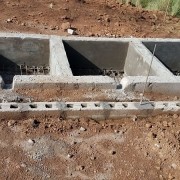 At the same time that this work was going on, our construction team had a week-long visit from Kenedy Mahili and his crew from the city of Mwanza, an eight-hour drive south of Bushasha. Kenedy is trained in construction of the biofil toilets that we will be using at the school. We were put in touch with him by an organization called Friendly Water for the World based in Olympia, Washington. Kenedy and his crew constructed three biofil toilets (minus the superstructure) which will serve as the start of our student toilet block. The photo shows the “working” part of the toilet. Earthworms are added on a bed of straw and soil on top of the wire mesh. This layer catches the solid waste, which is then digested by the worms, but it allows liquid to pass through and out into a soak pit.
At the same time that this work was going on, our construction team had a week-long visit from Kenedy Mahili and his crew from the city of Mwanza, an eight-hour drive south of Bushasha. Kenedy is trained in construction of the biofil toilets that we will be using at the school. We were put in touch with him by an organization called Friendly Water for the World based in Olympia, Washington. Kenedy and his crew constructed three biofil toilets (minus the superstructure) which will serve as the start of our student toilet block. The photo shows the “working” part of the toilet. Earthworms are added on a bed of straw and soil on top of the wire mesh. This layer catches the solid waste, which is then digested by the worms, but it allows liquid to pass through and out into a soak pit.
While constructing these toilets, Kenedy was also training several villagers in this technology, so they will be equipped to set up a business providing these safe and sustainable toilets for local families. The District Education Officer for this part of Tanzania also sent a representative from his department to attend Kenedy’s training. His hope is to encourage the use of biofil toilets in place of simple pit toilets at other rural schools. As part of the learning process, the trainees will construct the remaining three toilets and then Kenedy will come back to inspect their work. We hope they will pass the test!
Water tank
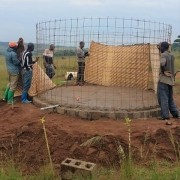 While on site, Kenedy and his crew also constructed a 20,000 liter ferrocement water tank to serve as the main holding tank for the water system that will supply the school and nearby villagers. We’ve chosen to use ferrocement since these tanks are reported to be less prone to cracking than concrete and also to last longer than plastic tanks, which degrade in the intense equatorial sun. The tank is formed by applying thin layers of cement to the inside and outside of a wire mesh frame, using some form of reed or grass thatching between the layers to hold the wet cement in place as it is being applied. Once again, Kenedy’s task was not only to construct the tank but to teach the method, so that more tanks of this type can be constructed in the future, either at Twegashe School or elsewhere in the village where water storage is needed.
While on site, Kenedy and his crew also constructed a 20,000 liter ferrocement water tank to serve as the main holding tank for the water system that will supply the school and nearby villagers. We’ve chosen to use ferrocement since these tanks are reported to be less prone to cracking than concrete and also to last longer than plastic tanks, which degrade in the intense equatorial sun. The tank is formed by applying thin layers of cement to the inside and outside of a wire mesh frame, using some form of reed or grass thatching between the layers to hold the wet cement in place as it is being applied. Once again, Kenedy’s task was not only to construct the tank but to teach the method, so that more tanks of this type can be constructed in the future, either at Twegashe School or elsewhere in the village where water storage is needed.
Roofing
Selection of a roofing system for the school has proven to be challenging. The wood truss systems commonly used in Tanzania are not easily adaptable to a large space like our cafeteria. Welded steel was another option we explored, but our design team had concerns about the difficulty of maintaining welding quality control. They have selected instead a third option, a light gauge steel roofing system manufactured by a company in Dar es Salaam. We learned that such a system was available back in January 2018 during our information-gathering trip across Tanzania visiting schools and looking at construction styles. Katoke-Lweru Secondary School, a few hours south of Bukoba, was using this system for the construction of their new dormitories. The Australian volunteer builder who is overseeing that project subsequently put us in touch with the company that produces this roofing system. Bill and Marc Oplinger (who heads our team of volunteer architects at Gensler) are working with this company now via email to finalize design details so they can provide a roofing system for Twegashe School. Once again we see the value of networking!
Volunteers
We’ve been fortunate to have several volunteers join the construction effort this fall. First were Bill Suhr’s adult children, Christoph and Isabel Suhr. Later that month, volunteer architect Marc Oplinger spent ten days in the village helping with foundations, and also hashing out design/structural details with Bill—much more efficient than their usual, not very reliable email communication. In early September, board member Chris Lindberg visited for two weeks. Chris has had years of experience working in forestry programs for the Peace Corps in Africa, so in addition to helping with construction, he also collected seeds and seedlings to get a start on a forestry program at Twegashe School. Finally, Frank Cech, an early CORE Tanzania supporter and a construction “hobbyist” will be spending almost three weeks in the village in November helping the crew make the push toward completing construction of the classroom building. Many thanks to these wonderful volunteers for making the long journey to Bushasha to lend their hands to the construction effort! And of course many, many thanks to our primary construction volunteer, Bill Suhr, who has been in the village now for almost five months, putting his life in the US on hold and persevering through all sorts of challenges and complications to make this Twegashe School project a success!

